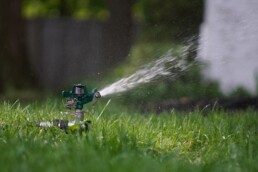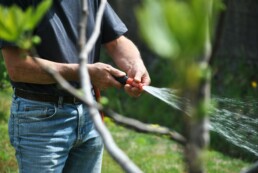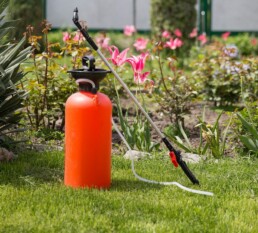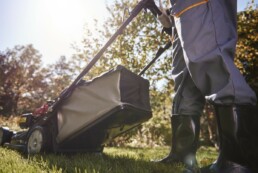If you’re a new homeowner, or you’ve just installed a new lawn, you may be wondering how to take care of sod properly. Sod is a great way to get a beautiful and lush lawn very quickly, but it does require special care in order to stay healthy and looking good. In this blog post, we will discuss the essentials of caring for sod grass. We’ll cover everything from watering and mowing to fertilizing and weed control. Follow these tips, and your sod will thrive!
Overview: How to Care for Sod
Laying sod is an excellent method of establishing a lush green lawn, but proper care is essential to keeping it healthy and looking good. There are three major aspects of sod care: watering, mowing, and fertilizing. Each aspect should follow a specific schedule based on the age of your sod and the variety of grass.
Since our company is based in Wisconsin, this article will focus on care for cool-season grasses, the most common type in our state. Cool-season grasses include Kentucky bluegrass, perennial ryegrass, and fine fescue. These varieties are well-suited to our climate, as they can tolerate cold winters and hot summers.
Maintaining a Proper Watering Schedule
Watering is perhaps the most important factor in sod care. Too much water will cause the roots to rot, while too little water will cause the grass to turn brown and die. Many homeowners don’t realize how sensitive plants are to overwatering, as it is a very common problem. Just like the plant tissue that is visible above ground, plant root tissue needs oxygen to survive. Overwatering prevents the roots from respiring and can kill your sod or , at the very least, cause it to become diseased.
It is essential to maintain a consistent watering schedule. When your sod is installed, your landscaper should properly water the sod to make the soil moist and encourage a sustainable root system. After that, it is up to you to maintain a consistent watering schedule.
Our team recommends watering frequently during the first few weeks after installation, especially in hot weather, because the roots will not have established themselves yet. Begin watering a few times daily to keep your lawn moist, but don’t water to the point of saturation (puddles). Soak the sod thoroughly enough that when a corner is lifted it is dripping wet. If you allow the sod to dry out, it will shrink and create gaps in your yard. If this happens you will need to replace your sod since it will not return to its original size.
Using an Irrigation System

If you plan to use a timed sprinkler system, set it to run around 5 times per day for 5-10 minutes each time. This will ensure sufficient water for the new sod. Be sure to monitor your irrigation system the first few times and adjust it as needed to prevent pooling and puddles. After about 10 days, the grass roots should begin to grow and the watering frequency and amount can be reduced.
Make sure your sprinkler heads properly covers every corner and edge of the sod. If they don’t you will need to adjust them or supplement those areas with hand watering. The edges and corners will dry out the quickest, so failure to care for those areas will kill your sod. Be sure to ask your landscaper for help adjusting your sprinkler heads if you don’t know how.
Hand Watering

If you plan to maintain a proper watering schedule with hand watering, our team recommends watering three times per day for approximately 15 minutes per watering session. This should be done in the morning, midday, & afternoon to prevent evaporation during the hottest part of the day.
Again, it is important to focus on the edges and corners when hand watering as those areas will dry out quickest. Remember don’t stop watering until the entire sod is wet and when you lift a corner, water should be dripping out.
Fertilizing a New Sod Lawn
Although many people only think of watering to care for plants, fertilizing is just as important. Fertilizer is essential for a healthy lawn because it provides the chemical elements that grass needs to grow. Just like people need food to survive, plants need nutrients to live and prosper.
Primary Essential Elements
There are three elements that are essential to plant or lawn growth: nitrogen, phosphorus, & potassium. Nitrogen helps the grass to grow quickly and produce a deep, green color. Phosphorus helps the roots to grow strong & develop quickly. Potassium strengthens the plants overall, making them more resistant to disease & pests.
When these three elements are properly balanced, they create a healthy environment for your sod to thrive. However, it is important to note that too much of any one element can be just as harmful as too little. This is why it is important to have your soil tested before you add any fertilizer.
A soil test will tell you the pH level of your soil as well as the levels of nitrogen, phosphorus, & potassium that are already present. Based on these results, you will be able to pick the correct fertilizer to apply to your sod. The elemental make up of each fertilizer is listed on packaging as parts NPK or parts nitrogen, phosphorus, & potassium. If you need help selecting the correct fertilizer ask your landscaper for guidance.
When to Fertilize

You should fertilize your new sod 4 to 6 weeks after installation. Brand new sod doesn’t require immediate fertilization because sod is grown in optimal conditions with proper fertilizer use. Give the sod time to establish its root system. This will allow the fertilizer to be properly absorbed. Once your sod is established, you can fertilize it two to four times per year depending on the type of grass.
Most lawn care experts suggest fertilizing in the spring, summer, & fall. This provides the grass with the nutrients it needs to survive the harsh winter and bounce back quickly in the spring. If you aren’t sure how to properly fertilize on your own, reach out to a local lawn care expert for help. Most lawn care services offer fertilizer applications as one of their lawn maintenance services.
Mowing a New Sod Lawn

Just like your established lawn needs mowing, new sod needs mowing too. However, you shouldn’t mow right away. Mowing takes away the grass’s food source. Remember plants photosynthesize to produce food. If you remove the grass blades, you prevent the grass from being able to produce food. If your sod doesn’t have sufficient food, it will struggle to establish strong roots and will be more likely to die.
You can mow new sod once it is about three inches tall. Once it reaches this height, don’t remove more than one third of the height when mowing. Removing too much will stress the grass and make it more difficult for it to recover. Use a sharp blade to avoid tearing the grass blades. Sod that is torn is more susceptible to disease & pests.
When to Mow New Sod
You should wait to mow your new sod until it is fully rooted into the ground. This takes approximately two weeks, but depends on the type of grass. For example, Kentucky Bluegrass takes approximately 21 days to fully root. Once it is rooted, you can mow it according to the recommended height for your type of grass.
Riding Mowers & New Sod

Don’t use riding mowers on a new sod lawn. Riding mowers are heavy and their powered drive train can tear up your brand new sod. Instead, use a push mower with a sharp blade. This will help you avoid damaging your new sod. After your lawn is established, you can choose to use riding mowers if you prefer.
Treating New Sod Right
New sod is tricky to care for properly. There are numerous problems to be aware of that can harm your new sod. Be patient and take the time to do things right. Your lawn will thank you for it in the long run. Proper care of new sod requires attention to detail & a willingness to put in the extra work upfront. Outside of specific care routines, there are a few things you should keep in mind. These will help you avoid common problems & ensure your new sod has a chance to thrive.
Avoid Walking or Foot Traffic

As much as possible, avoid walking or driving on new sod. This can compact the soil & damage the roots of the grass. If you must walk on your new sod, avoid doing so when it is wet. Wet soil is more likely to be compacted than dry soil.
After about two weeks, your new sod will be strong enough to withstand light foot traffic. However, it is still best to avoid driving or parking on your new sod lawn. In fact, it is best to avoid this in general since soil compaction leads to a variety of problems including poor drainage & a shallow root system.
Weed Control
Just like fertilizing, weed control is important for new sod. Weeds compete with your grass for water, sunlight, & fertilizer. This can stress the grass & make it more difficult for it to establish a strong root system.
Pre-emergent herbicides are typically applied before weeds appear. This prevents them from germinating in the first place. Post-emergent herbicides are applied after weeds have already germinated. These kill the existing weeds.
It is best to wait until your new sod is fully rooted before applying either type of herbicide. This typically takes about two weeks, but may take longer depending on the type of grass you have installed.
If you don’t have the proper protective equipment to apply pesticides, we recommend contacting a professional. This will ensure the job is done correctly & safely. Be sure whoever you hire has a pesticide applicators license to work in your state.
Frequently Asked Questions About Proper Sod Care
Caring for sod is difficult, but now you should have a good idea of the many things you need to do. Here are some frequently asked questions we receive about sod care that you might find helpful.
Why are there discolored spots on my new sod?
This is usually caused by pet urine. The high levels of nitrogen in pet urine can burn the grass, causing it to turn brown or yellow. The best way to avoid this is to keep your pets off the sod until it has had a chance to fully root into the ground.
Generally speaking pet urine is only a problem on new sod. Once the grass is established, it will be much more tolerant of pet urine. Remember, nitrogen is one of the essential elements for plant growth. In moderation, it can actually be beneficial for your lawn.
Should sod turn brown?
Your sod shouldn’t turn brown if it is cared for properly. In fact, it should stay green all year long. However, there are a few things that can cause your sod to turn brown. These include disease, pests, compaction, poor drainage, & a lack of nutrients.
If you notice your sod turning brown, we recommend contacting a professional. They will be able to diagnose the problem & recommend a solution. Unfortunately, the right solution might be replacing the sod if you waited too long to address the problem.
What is the best time of year to install sod?
Although sod can be installed at any time of year, the best time to install sod is in the spring or fall. This is because the temperature is moderate & there is typically more rainfall. Hot, dry weather can stress sod & make it more difficult to establish a strong root system.
Installing sod in the summer can be very difficult. If you do choose to install sod in the summer, you will need to take the maintenance very seriously. This includes watering the sod even more than is needed during the spring.
Need Help Maintaining Your Yard in Madison, WI?
If you need help maintaining your yard or lawn, our team of experts at Sun Prairie Lawn and Landscape can assist you. Our team provides lawn care, landscaping, & snow removal services in Madison, WI and the surrounding area. Contact us today for a free quote!


Additional Resources:
Have a project we can help with?
Give us a call or complete our contact form to get in touch with our team.
